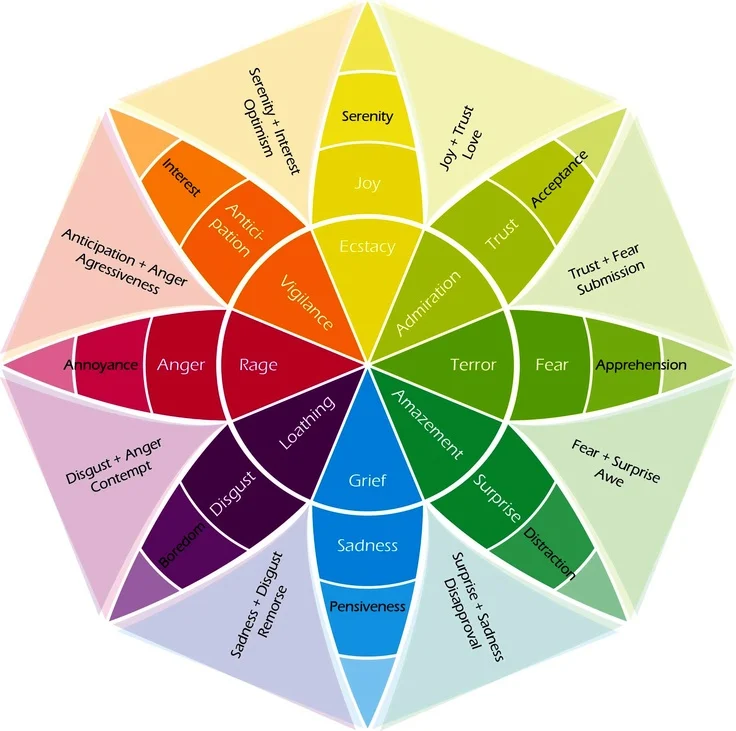
Knowing about human emotions is a psychological aspect. However, if you really want to understand the nitty-gritty of Human Emotions, you must first understand emotions and the chemistry associated with them. What makes us who we are and contributes to our quality of life is how we interpret and respond to the world around us.
Emotional psychology allows researchers to delve into what causes humans to react in certain ways to certain stimuli, as well as how those reactions affect us physically and mentally. While the field of emotional psychology is vast and complex, researchers have learned a lot about what causes us to feel emotions and how we respond to them behaviorally and physically.
Emotions Defined
Feelings and moods are frequently confused with emotions, but the three terms are not interchangeable. Emotion is defined by the American Psychological Association (APA) as “a complex reaction pattern involving experiential, behavioural, and physiological elements.” Emotions are how people react to things that are important to them. A subjective experience, a physiological response, and a behavioural or expressive response are the three components of emotional experiences.
Emotional experiences give rise to feelings. This is classified in the same category as hunger or pain because a person is aware of the experience. An emotion produces a feeling, which can be influenced by memories, beliefs, and other factors.
The American Psychological Association defines a mood as “any short-lived emotional state, usually of low intensity.” Moods are distinct from emotions in that they lack stimuli and have no clear beginning point. Insults, for example, can elicit the emotion of rage, while an angry mood can emerge for no apparent reason.
Emotion definition is still a work in progress. Many researchers are still proposing theories about what makes up our emotions, and existing theories are being challenged on a regular basis. Even so, there is a solid foundation of knowledge to examine when delving deeper into the subject.
The Emotional Process
While there is some disagreement about the order of events, everyone agrees that emotions are made up of three parts: subjective experiences, physiological responses, and behavioural responses. Let’s take a closer look at each of these components.
Personal Experiences
All emotions start with a subjective experience, also known as a stimulus, but what exactly does that imply? While all people, regardless of culture or upbringing, experience basic emotions, the experience that causes them can be highly subjective.
Subjective experiences can range from something as simple as seeing colour to something as significant as the death of a loved one or the marriage of a spouse. No matter how intense the experience is, it can elicit a wide range of emotions in a single person, and the emotions each person feels may differ. For example, one person may be angry and regretful over the death of a loved one, while another may be deeply saddened.
Physiological Effects
We’ve all experienced the sensation of our heart racing with fear. The autonomic nervous system’s reaction to the emotion we’re experiencing causes this physiological response. The autonomic nervous system regulates our fight-or-flight response and controls our involuntary bodily responses. Many psychologists believe that our physiological responses have helped us evolve and survive as humans throughout history.
Autonomic physiological responses are strongest when a person’s facial expressions most closely resemble the expression of the emotion they’re experiencing, according to studies. In other words, in a physical sense, facial expressions play an important role in responding to emotion.
Reactions Behavioral
The actual expression of the emotion is the behavioural response aspect of the emotional response. A smile, a grimace, a laugh, or a sigh are just a few examples of behavioural responses, which vary depending on societal norms and personality.
While plenty of research suggests that many facial expressions are universal, such as a sad frown, our behavioural responses are influenced by socio-cultural norms and upbringing. For instance, the way people express love differs from person to person and across cultures.
Behavioural responses are important for signalling how we’re feeling to others, but research shows they’re also important for people’s well-being. The suppression of behavioural responses to emotion had physical effects on participants while watching negative and positive emotional films, according to a study published in the Journal of Abnormal Psychology. Elevated heart rates were among the side effects. This suggests that expressing positive and negative behavioural responses to stimuli is better for your overall health than keeping them hidden. Smiling, laughing, and expressing negative emotions in a healthy way all have advantages.
Emotion is much more than a mental state, as evidenced by the physiological and behavioural responses associated with it. Emotion has an impact on our entire demeanour as well as our health. Furthermore, our ability to comprehend others’ behavioural responses is critical to our emotional intelligence, which will be discussed in greater depth later.

Psychology And Emotions
Emotional theories and hypotheses have been around for centuries. In fact, the Book of Rights, a first-century Chinese encyclopaedia, mentions basic or primary emotions. Emotion is much more difficult to quantify and define than many other human responses. Emotional psychology research has focused on basic emotions, our psychological and behavioural responses, and the role of emotional intelligence in our lives.
Emotions: Simple And Complex
Emotions are divided into two categories in emotional psychology: basic and complex.
Basic emotions are linked to recognisable facial expressions and tend to occur spontaneously. The first person to suggest that emotion-induced facial expressions are universal was Charles Darwin. This idea was central to his evolutionary theory, implying that emotions and their expressions were biologically and adaptively important. Researchers have been observing emotions in animals for several years, implying that they are important for survival in other species as well. Throughout human evolution, basic emotions are likely to have played a role in our survival, signalling to those around us to react accordingly.
Paul Ekman, an emotional psychologist, identified six basic emotions that could be deduced from facial expressions. Happiness, sadness, fear, anger, surprise, and disgust were among them. In 1999, he added embarrassment, excitement, contempt, shame, pride, satisfaction, and amusement to the list, though those additions were not widely adopted.
The Six Basic Emotions are listed below.
- Sadness
- Happiness
- Fear
- Anger
- Surprise
- Disgust

In the 1980s, psychologist Robert Plutchik identified eight basic emotions, which he divided into pairs of opposites, including joy and sadness, anger and fear, trust and disgust, surprise and anticipation, and surprise and anticipation. A wheel of emotions is a classification that is similar to a colour wheel in that certain emotions when mixed together can create new complex emotions.
In 2014, a new study from the University of Glasgow’s Institute of Neuroscience and Psychology discovered that instead of six easily recognisable basic emotions, there may only be four. The study discovered that anger and disgust, as well as surprise and fear, had similar facial expressions. This implies that the differences in those emotions are sociological rather than biological in nature. Despite all of the contradictory research and adaptations, the majority of studies agree that a set of universal basic emotions with recognisable facial features exist.
DEGREE EXPLORATION IN EMOTIONS
Grief, jealousy, and regret are examples of complex emotions that have different appearances and may not be as easily recognised. The APA defines complex emotions as “any emotion that is an aggregate of two or more others.” Hate, for example, is a fusion of fear, anger, and disgust. Fundamental emotions, on the other hand, are pure and natural. Love, embarrassment, envy, gratitude, guilt, pride, and worry are just a few of the many complex emotions.
Complex emotions have a wide range of expressions on a person’s face and are difficult to recognise. Grief manifests itself in a variety of ways depending on the culture and the individual. Some complex emotions, such as jealousy, maybe expressed entirely without a facial expression.
Emotional Theories
Emotion, as we’ve seen, is complex and debatable. As a result, there are numerous theories of emotion. While some theories directly contradict others, many others build on top of one another. Here are some common emotional psychology theories that have influenced the field and how people think about emotions.
The James-Lange Hypothesis
One of the earliest emotion theories in modern psychology is the James-Lange Theory of Emotion. The theory, which was developed in the 19th century by William James and Carl Lange, states that physiological stimuli (arousal) cause the autonomic nervous system to react, causing individuals to experience emotion. A racing heart, tense muscles, sweating, and other nervous system reactions are possible. The physiological response, according to this theory, comes before emotional behaviour. The James-Lange theory has been questioned and expanded upon in other theories over time, implying that emotion is a combination of physiological and psychological responses.
Theory of Facial-Feedback
According to the Facial-Feedback Theory of Emotion, facial expressions are essential for experiencing emotion. This theory is linked to the work of Charles Darwin and William James, who proposed that facial expressions influence emotion rather than being a reaction to it. According to this theory, emotional changes in the face muscles are directly linked to physical changes in the face muscles. As a result, someone who forced a smile would be happier than someone who frowned.
The Cannon-Bard Hypothesis
The Cannon-Bard Theory of Emotion was developed in the 1920s by Walter Cannon and Philip Bard to refute the James-Lange theory. This theory proposes that bodily changes and emotions happen at the same time rather than one after the other. This theory is supported by neurobiological research, which claims that when a stimulating event is detected, the information is simultaneously relayed to the amygdala and the brain cortex. If this is correct, arousal and emotion occur at the same time.
The Schachter-Singer Hypothesis
Stanley Schachter and Jerome E. Singer developed this theory, which incorporates reasoning into the emotional process. According to the theory, when we experience an event that causes physiological arousal, we try to figure out why. Then we have the emotional experience.
Theory of Cognitive Appraisal
Richard Lazarus was the first to propose this theory of emotion. Thinking must occur before experiencing emotion, according to the Cognitive Appraisal Theory. As a result, a person would first be exposed to a stimulus, think about it, and then experience a physiological response and emotion all at the same time.
These are far from the only theories of emotion that exist, but they serve as excellent examples of how different perspectives on how emotion is generated differ. The idea that emotion is based on some sort of personally significant stimulus or experience, prompting a biological and psychological response, is shared by all theories of emotion.

Understanding Emotions Has Many Advantages
Emotions, as previously stated, have aided human evolution and survival. “It would be very dangerous if we didn’t have emotions,” says Ekman, the creator of the emotion wheel. It would also be a very boring existence. Because, at the end of the day, it’s our emotions that drive us — excitement, pleasure, and even anger.” That is why it is critical that we understand emotions because they play such a significant role in our behaviour.
Ekman contends that emotions are inherently beneficial. They are influenced by what is best for our species as a whole and what we learned as children. They direct our actions in a way that should result in a favourable outcome. Emotions, on the other hand, can be destructive if the emotions we’ve learned to be the appropriate response no longer apply to our situation, or if subconscious emotions cause uncontrollable reactions. Emotional awareness refers to being in touch with your emotions and putting your understanding into action. Emotional intelligence refers to the ability to do this with others as well.
The Ability to Perceive
The ability to perceive, control and evaluate emotions is referred to as emotional intelligence. Researchers Peter Salovey and John D. Mayer coined the term, which gained popularity thanks to Dan Goleman’s 1996 book. They define it as the ability to recognise, understand, and manage one’s own emotions, as well as the ability to recognise, understand, and influence the emotions of others. Since the mid-1990s, the study of emotional intelligence has grown in popularity, with business professionals, relationship coaches, and others using the term to motivate others to improve their lives. Emotional intelligence, according to many researchers, can be improved over time, while others argue that it is a trait that we are born with or without.
Emotional intelligence consists of the following elements:
Appraising and expressing one’s own and others’ emotions: Recognizing and expressing emotion through verbal and nonverbal cues
Regulating one’s own and others’ emotions: Managing emotions so that everyone is motivated to achieve a positive result.
Adaptive emotional expression: Using emotion and how emotions are interpreted to achieve positive results.
Emotional Intelligence
Emotional intelligence allows people to be open to both positive and negative emotional experiences, identify emotions, and communicate them appropriately. Emotionally intelligent people can use their knowledge of their own and others’ emotions to advance in their personal and social lives. Low emotional intelligence can make it difficult to understand and control one’s own or others’ emotions. When others don’t understand your emotions, feelings, or expressions, it can make them feel bad.
Improving your emotional intelligence has obvious personal and professional benefits. Chade-Meng Tan, the co-chair of the Nobel Peace Prize-nominated campaign and New York Times best-selling author, spoke about the benefits of emotional intelligence in Forbes. He asserted that high emotional intelligence is linked to better work performance, makes people better leaders, and fosters personal happiness. “There are also compelling personal benefits,” he said, “and the most basic of those is calmness and clarity of mind, resilience, and more satisfying relationships.”
Emotional intelligence, like traditional intelligence, plays a role in overall success. In fact, some researchers believe it has a greater impact. Daniel Goleman, a psychologist, first proposed the concept of an EQ in his 1995 book “Emotional Intelligence: Why It Can Matter More Than IQ.” An EQ, like an IQ, is a measurement of a person’s emotional intelligence ability. When it comes to success, Goleman claims that EQ matters twice as much as IQ and technical skills combined.
Although whether or not this is true is debatable, emotional intelligence has proven to be beneficial to humans throughout our evolution and history. It had a role long before it was formally defined, and it will continue to do so for many years to come.
Different Emotions And The Chemical Involved.
Emotions are a complex experience that is categorised by states of mind, external and internal reactions, and expressions, but they are essentially a conscious experience that is categorised by states of mind, external and internal reactions, and expressions.
A variety of emotions exist, including affection, anger, angst, anguish, annoyance, anxiety, apathy, arousal, awe, boredom, confidence, contempt, contentment, courage, curiosity, depression, desire, despair, disappointment, disgust, mistrust, dread, euphoria, excitement, fear, frustration, gratitude, grief, guilt, happiness, hatred, hope, horror, hostility, hurt, hatred, hope, horror, hostility,
Emotions aren’t made of anything, but they can be described by how we feel them. Emotions are a result of the nervous system’s arousal. At any given time, millions of chemical reactions occur in the brain. Synapses are responsible for chemical reactions. Synapses are components of the nervous system that allow neurons to send and receive messages via neurotransmitters.
Physiological Responses
Physiological responses such as a racing heart, sweating, blood rushing to the face, and the release of adrenaline are commonly used to measure emotions. Emotions include a significant amount of expression. Parts of the nervous system such as the motor cortex, limbic system, and brain stem are associated with expression. The frontal lobes and the amygdala are the parts of the nervous system that have the most impact on emotion. The frontal cortex is frequently linked to feelings of joy and pleasure. The amygdala is linked to emotions such as anger, fear, and sadness.

Throughout the day, we are exposed to a wide range of emotions. The majority of these feelings are fleeting. However, when these emotions become intensely negative or unrelenting, they can have a significant impact on our biochemistry and behaviour. Emotions are controlled by specific brain areas and levels of various chemicals in the brain. When we are in danger, for example, our brain releases stress hormones, which can trigger fight or flight responses by flooding specific areas with the neurotransmitter epinephrine (adrenaline). When the threat has passed, our brain sends out a calming signal in the form of chemicals, which inhibits the stress response.
Hormones and chemicals are responsible for keeping the body in good working order. A few of them are listed below, along with how their balance affects how our moods, emotions, and stresses are triggered.
Female Reproduction and Positive Mood Hormone: Oestrogen

Oestrogen is the primary sex hormone released by women’s ovaries. The ability of oestrogen to increase serotonin and endorphins, chemicals associated with positive mood states, has an effect on emotions. Oestrone, estradiol, and estriol are three major endogenous oestrogens in females with estrogenic hormonal activity. The oestrone steroid is the most powerful and widely used.
Low oestrogen levels are linked to depression, anxiety, and mood swings in women, as seen in premenstrual syndrome, premenstrual dysphoric disorder, and postpartum depression. High oestrogen levels, on the other hand, can cause havoc with our bodies. As a result, a proper biochemical balance is required for the proper functioning of the steroid hormones system. Oestrogen aids in the maintenance of serotonin, dopamine, and norepinephrine levels by lowering the level of monoamine oxidase, the enzyme that causes their deactivation.
Female Ovulation and Calming Hormone: Progesterone

Progesterone is a female sex hormone produced by the corpus luteum, a temporary gland within the ovaries that plays an important role in reproduction. Progesterone concentrations have a strong influence on our brains. Insomnia, anxiety, and migraine are all symptoms of an oestrogen and progesterone imbalance. It works to counteract the effects of oestrogen. Progesterone has a calming effect on the brain, whereas oestrogen has an excitatory effect. Progesterone has been shown to have anxiolytic (anti-anxiety) effects in the brain by activating gamma-aminobutyric acid (GABA) receptors. GABA is an inhibitory neurotransmitter that promotes sleep and relaxation.
Motivation and Reward Chemical:Dopamine

Dopamine is a neurotransmitter produced by the hypothalamus that regulates focus, attention, memory, drive, muscle control, and ovulation. It is linked to vigilance, memory, cognition, happiness, and alertness. Depression, impulsivity, mood swings, attention deficit, cognitive issues, compulsive behaviour, cravings, apathy, and loss of satisfaction in life activities can all be symptoms of low dopamine levels in the body. As seen in schizophrenia, it prevents rational thought.
Dopamine is a key component of the brain’s reward system, and high levels can lead to addictive behaviour, suspicious personality, and even paranoia.
There are no foods that provide dopamine directly, but foods high in tyrosine and phenylalanine, the amino acids needed to make dopamine, may be beneficial. Protein-rich foods such as turkey, chicken, milk, cheese, and eggs contain both of these amino acids.
Happiness Hormone:Serotonin

Serotonin regulates a wide range of physiological and biological functions, including mood, arousal, aggression, thinking abilities, and memory. It levels in the right range are linked to relaxation and improved mood. Serotonin excess causes sedation and apathy, whereas serotonin deficiency causes low mood, lack of willpower, poor appetite control, anxiety disorders, depression, social behaviour, and sexual problems.
Anxiety disorders, depression, impulsivity, mood disorders, sleep-wake cycle disturbances, obesity, eating disorders, and chronic pain are all linked to serotonin disruptions. Meditation increases serotonin production by inhibiting activity in the stress-producing regions of the brain.
Information Processor Neurotransmitter:Acetylcholine

The primary neurotransmitter released from nerve endings in both the central and peripheral nervous systems is acetylcholine. Muscle movement, alertness, concentration, and memory are all controlled by it. When levels are at their best, mood improves, the mind becomes more focused, and intelligence rises. However, with low levels of learning and recall, one’s ability to think clearly can suffer.
It also regulates primal emotions and drives such as rage, fear, and aggression. These emotions can affect both the individual and those around them when these neurotransmitters are out of balance.
It’s worth noting that acetylcholine and serotonin have an inverse relationship (if one increases the number of other decreases). In small doses, Ach acts as a brain stimulant by stimulating the release of dopamine and serotonin. However, too much Ach inhibits the brain and leads to depression.
Protein-rich foods, such as eggs, fish, dairy, soy products, poultry, and foods containing lecithin, significantly raise Ach levels. Supplements that significantly raise Ach levels include choline, lecithin, fish oil, and flaxseed oil. Certain medications, chemicals, and physical activity also raise Ach levels.
The Bonding Hormone: Oxytocin

The hypothalamus produces oxytocin, which is then released into the bloodstream by the pituitary gland. It is involved in pro-social behaviour, sexual reproduction, and childbirth before, during, and after the birth of a child. Oxytocin inhibits brain areas associated with behavioural control of fear and anxiety and protects against stress. It evokes feelings of contentment, calmness, security, and a reduction in anxiety level.
By inhibiting the amygdala, oxytocin given orally has been shown to reduce fear (brain area responsible for fear responses). It promotes romantic attraction and subsequent monogamous pair bonding by increasing trust, empathy, and social interaction.
MDMA (3,4-Methylenedioxymethamphetamine), also known as ecstasy, stimulates oxytocin activity in the brain, which increases feelings of love, empathy, and connection.
Deficiency of oxytocin is linked to poor communication, increased anxiety and fear, disturbed sleep, sugar cravings, and irritability in the pathophysiology of depression.
Brain Activity Regulator:GABA (gamma-aminobutyric acid)

GABA is a neurotransmitter that is produced in the body from glutamic acid (an amino acid). It reduces fear, anxiety, and panic by slowing down the activity of the limbic system (the emotional alarm bell).
It works as a natural sedative, suppressing the hormone prolactin, which causes nighttime incontinence.
The production of GABA is aided by glutamic acid and vitamin B6. Zinc also promotes the release of GABA and inhibits the release of glutamate, an excitatory neurotransmitter.
The majority of bipolar disorder patients have low GABA levels, which accounts for their restlessness and anxiety.
Primary Male Hormone:Testosterone

Testosterone is a hormone produced by the testes in men and the ovaries in women to a lesser extent. It promotes muscle growth, libido, bone mass, muscle strength, and energy levels.
Testosterone has an effect on the parts of the brain that control emotions. People with high levels of endogenous testosterone have less activity in prefrontal brain regions and less communication between the prefrontal brain and the amygdala (the brain’s emotion control regions), which increases the risk of aggressiveness, depression, impulsivity, anger, mood swings, and decreased empathy.
Too little testosterone can also harm a man’s emotional vitality, causing passivity, depression, anger, irritability, feelings of insecurity, and anxiety.
Epinephrine and norepinephrine

Endorphins are neurotransmitters, which are chemicals that transmit signals from one neuron to another. Endorphins are a class of neurotransmitters that include three compounds: – endorphin, – endorphin, and – endorphin. Neurotransmitters play a key role in the function of the central nervous system and can either prompt or suppress the further signalling of nearby neurons.
Endorphins are released in response to a variety of stimuli, including stress, fear, and pain. They originate in various parts of the body, including the pituitary gland, spinal cord, and various parts of the brain and nervous system, and interact primarily with receptors in cells found in brain regions that control pain and emotion.

Endorphins are responsible for our feelings of pleasure as well as pain relief. It’s widely assumed that these feelings of pleasure exist to let us know when we’ve had enough of a good thing, as well as to encourage us to pursue that good thing in order to experience the associated pleasure. Maintaining a balance in these brain chemicals is crucial for achieving balanced emotions. Altering the levels of these key chemicals through a balanced diet, limiting stress, constructive thoughts, yoga, pranayama, and meditation can all help to maintain emotional health to some extent.
The four major hormones that determine a person’s happiness, namely, dopamine, endorphins, serotonin, and oxytocin are all neurotransmitters. Let’s look at what causes the body to produce more of these hormones.
Endorphins are released when we exercise. This hormone aids the body’s ability to cope with the discomfort of exercise. We then look forward to exercising because the Endorphins will make us feel good. Endorphins can also be produced through laughter. To get our daily dose of endorphins, we need to exercise for 30 minutes every day, read or watch funny things.
Dopamine
When we complete a number of small and large tasks, the second hormone, dopamine, is released. When we are praised for our work at work or home, we feel accomplished and good because Dopamine is released. This also explains why most housewives are unhappy because their efforts are rarely recognised or appreciated. We buy a car, a house, the latest gadgets, a new house, and so on once we start working. It releases Dopamine in each case, making us happy. Is this another reason we get excited when we go shopping?
Serotonin
When we act in a way that benefits others, the third hormone, Serotonin, is released. Serotonin is released when we transcend ourselves and give back to others, nature, or society. Serotonin is produced by providing useful information on the internet, such as writing information blogs, answering people’s questions on Quora, or participating in Facebook groups. That is because we will devote our valuable time to assisting others through our answers or articles.
When we get close to other people, the final hormone, Oxytocin, is released. Oxytocin is released when we hug our friends or family. Similarly, different amounts of Oxytocin are released when we shake hands or put our arms around someone’s shoulders.
Oxytocin
Now we know why we should hug a sad child. simple: It’s we need to exercise every day to get Endorphins, we need to achieve small goals to get Dopamine, we need to be nice to others to get Serotonin, and we need to hug our kids, friends, and families to get Oxytocin, and we will be happy. We can better deal with our challenges and problems when we are happy.
Note: Contact our Writers at www.eastsidewriters.com for writing Blogs/Articles on any niche. We have experts in various domains from Technology to Finance and from Spirituality to Lifestyle and Entertainment.
Originally posted 2021-07-17 09:41:13.







Pingback: Know All About Human Emotions And The Chemistry Associated With It
Pingback: Tips To Help You To Concentrate While in Meditation.
Pingback: Secret Benefit Of The Lipstick That You Wear In 2023 - Eastside Writers
Pingback: How To Enrich Your Life With Contentment And Fulfilment - Eastside Writers
Pingback: What Are Sattvic, Rajasic, And Tamasic Foods And Their Significance To Our Health
Pingback: The Power of Conscience: Upholding Moral and Ethical Values in Our Lives - Eastside Writers
Pingback: The Power of Estrogen - Unveiling the Surprising Benefits and Risks of the Hormone - Eastside Writers
Pingback: Is Your Boss a Psychopath? Recognizing Signs of Workplace Psychopathy - Eastside Writers